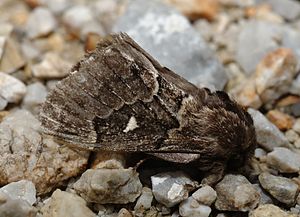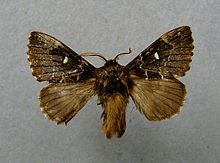Moon spot luck
| Moon spot luck | ||||||||||||
|---|---|---|---|---|---|---|---|---|---|---|---|---|

Mondfleckglucke ( Cosmotriche lobulina ) |
||||||||||||
| Systematics | ||||||||||||
|
||||||||||||
| Scientific name | ||||||||||||
| Cosmotriche lobulina | ||||||||||||
| ( Denis & Schiffermüller , 1775) |
The Mondfleckglucke ( Cosmotriche lobulina ), sometimes referred to as the coniferous moon spot spinner or Kienbaumspinner , is a butterfly ( moth ) from the mother hen family (Lasiocampidae).
features
Imago
The sexes differ in size and reach a wingspan of 32 to 38 millimeters for the males and 38 to 46 millimeters for the females. Typical and eponymous for the species is a large, white, crescent-shaped discal spot on the forewings. Two jagged wavy lines delimit the disc field . There is a great deal of variation in terms of coloration. The gray form ( f. Lunigera ), Esper 1784, was largely replaced by forms with different degrees of darkening, whereby the following should be mentioned:
- f. lobulina , Esper 1789, with a black base color, different or almost missing band markings, gray scales in the forewing and deep black body
- f. intermedia , Rebel 1910, with only a black middle field in the forewing
- f. cerberus , Daniel 1952, describes completely blackened butterflies without recognizable drawing elements , except for the white discal spot
- f. marginata , Bergmann 1953, describes Falter with a whitish lightened border
egg
The egg is large, oblong and round and whitish blue-green in color. There is a dark spot at each pole.
Caterpillar
The caterpillars are blue-black or blue-gray with irregular yellow or white spots on the back. On the back there are brush-like black hairy spots. The lateral hair is long and soft. The head is blue-black.
Doll
The doll is yellow-gray with a blunt Kremaster without bristles.
Synonyms
- Cosmotriche lunigera
- Selenephera lunigera
Occurrence
The distribution of the species extends from Europe to East Asia . It prefers sunny forest edges and aisles in spruce forests. In the Alps it can be found up to 1200 meters above sea level.
Way of life
The moths are nocturnal and like to fly to artificial light sources . The females usually lay the eggs individually on the branches of the food plants. The caterpillars overwinter either in their juvenile stage or almost adult, depending on whether they descend from early summer or late summer butterflies. Pupation takes place in a flat, yellow-brown or dirty-gray web interspersed with hair in crevices or forked branches.
Flight and caterpillar times
The moths appear in two different strains in May and June and in July and August. Depending on the region, climatic conditions or altitude, different flight periods can also be determined. The caterpillars can be found in the following months: trunk 1 from June to April of the following year and trunk 2 from September to June of the following year. Further observations of both the adults and the pre-imaginal stages are necessary in order to clarify unanswered questions about the biological differences of the moon-spot huckles.
Food of the caterpillars
The caterpillars prefer to feed on the needles of pine ( Pinus ), spruce ( Picea ) and fir ( Abies ).
Hazard and protection
The Mondfleckglucke is widespread in Germany and mostly found locally. Inclusion in the Red List of Endangered Species is not urgent. In areas where the air has been contaminated by dust and soot , not only are the conifers damaged, but also many caterpillars of the moonspot caterpillars die which eat contaminated food.
swell
Individual evidence
- ↑ a b c JJ de Freina: The Bombyces and Sphinges of the Western Palaearctic. Volume 1. Noctuoidea, Sphingoidea, Geometoidea, Bombycoidea. EFW Edition Research & Science Verlag GmbH, Munich, 1987, ISBN 3-926285-00-1
- ↑ a b c d Walter Forster, Theodor A. Wohlfahrt: The butterflies of Central Europe. Volume 3: Weirdos and Swarmers. (Bombyces and Sphinges). Franckh'sche Verlagshandlung, Stuttgart 1960, DNB 456642196 .
- ↑ a b c Manfred Koch: We determine butterflies. Volume 2: Bears, Spinners, Swarmers and Drills in Germany. 2nd, expanded edition. Neumann, Radebeul / Berlin 1964, DNB 452481929 .
- ↑ a b Günter Ebert (Hrsg.): The Butterflies of Baden-Württemberg Volume 4, Moths II (Bombycidae, Endromidae, Lasiocampidae, Lemoniidae, Saturniidae, Sphingidae, Drepanidae, Notodontidae, Dilobidae, Lymantriidae, Ctenuchidae), Nolidae. Ulmer Verlag Stuttgart 1994, ISBN 3-8001-3474-8
literature
- Günter Ebert (Ed.): The Butterflies of Baden-Württemberg Volume 4, Moths II (Bombycidae, Endromidae, Lasiocampidae, Lemoniidae, Saturniidae, Sphingidae, Drepanidae, Notodontidae, Dilobidae, Lymantriidae, Ctenuchidae, Nolidae). Ulmer Verlag Stuttgart 1994, ISBN 3-8001-3474-8
- JJ de Freina: The Bombyces and Sphinges of the Western Palaearctic. Volume 1. Noctuoidea, Sphingoidea, Geometoidea, Bombycoidea. EFW Edition Research & Science Verlag GmbH, Munich, 1987, ISBN 3-926285-00-1
- Walter Forster , Theodor A. Wohlfahrt : The butterflies of Central Europe. Volume 3: Weirdos and Swarmers. (Bombyces and Sphinges). Franckh'sche Verlagshandlung, Stuttgart 1960, DNB 456642196 .
- Manfred Koch : We determine butterflies. Volume 2: Bears, Spinners, Swarmers and Drills in Germany. 2nd, expanded edition. Neumann, Radebeul / Berlin 1964, DNB 452481929 .
Web links
- www.lepiforum.de Taxonomy and photos
- www.faunaeur.org/full_results.php?id=295123 Taxonomy (English)
